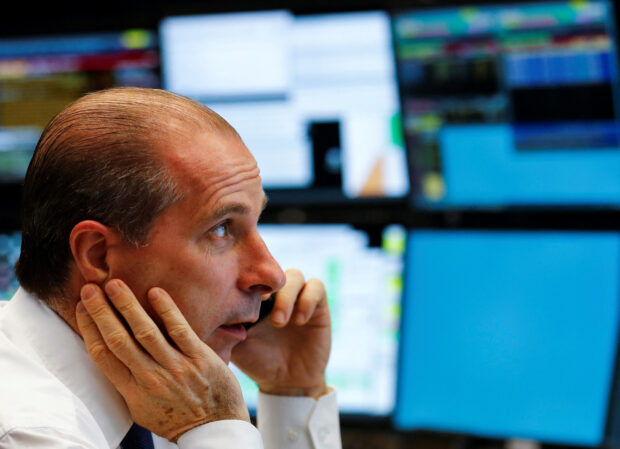Dollar hits 2-month low before US inflation data

A trader works at the Frankfurt stock exchange, amid the coronavirus disease (COVID-19) outbreak, in Frankfurt, Germany, Dec 30, 2020. REUTERS/Ralph Orlowski/File photo
LONDON – Bets on a screeching slowdown in U.S. inflation data later saw traders shove the dollar to a 2-month low on Wednesday and push stocks up and bond market borrowing costs down for a third day running.
Economists polled by Reuters expect to see June U.S. consumer price inflation slow to 3.1 percent from 4 percent in May, which might be enough to convince the Federal Reserve to end its aggressive rate hikes – if not this month, at least soon.
READ: US consumer inflation eases for 11th straight month
Europe’s main stock markets had opened 0.7 percent higher, led once again by the high-flying tech sector, and MSCI’s main 47-country world index was up a full 20 percent from rate hike-induced lows hit in October.
The currency market was moving too. The dollar’s low meant it notched its longest losing stretch since March. The yen clambered back above 140 and sterling hit a 15-month high as the Bank of England said the UK was coping with higher interest rates.
“Risk assets, as usual, seem to take the best out of whatever is happening.” said James Athey, an investment director and fund manager Abrdn in London.
For the CPI data, the core reading which strips out volatile elements such as energy prices, will matter the most for markets, he added.
“If it doesn’t give the impression of the immediate cessation of these price pressures we could see a reversal of some of these more recent market moves,” Athey said, such as the rebound in the yen and drop in short-term U.S. bond yields.
That core rate is expected to have dropped for a third month to 5 percent from 5.3 percent , according to the Reuters poll, though that is more than double the Fed’s 2 percent target.
Markets are pricing in a 92-percent chance of a 25-basis-point Fed hike later this month, the CME FedWatch tool showed, but remain doubtful of further hikes after that.
READ: Fed leaves rates unchanged, sees two small hikes by end of 2023
Wednesday’s moves saw euro zone bond yields inch lower, with Germany’s 10 year yield dipping to 2.62 percent, having hit a four-month high of 2.679 percent on Monday. U.S. Treasury yields were a touch lower as well, with the 10-year Treasury yield now at 3.95 percent.
Saxo Markets strategists said traders were likely to continue to keep the odds for September and November rate hikes low if the core inflation rate decelerates as anticipated.
Investor attention will also be on the Bank of Canada, with analysts expecting a second consecutive quarter-point rate hike at its upcoming meeting.
READ: Bank of Canada hikes rates to 22-year high, more increases expected
In June, the central bank raised its overnight rate to a 22-year high of 4.75 percent after a five-month pause, saying monetary policy was not restrictive enough. It then said further moves would depend on economic data.
Lingering fear
A speech by Bank of England governor Andrew Bailey was on the watch list as well, though this will be about financial stability so may have little impact on expectations for monetary policy.
“The great lingering fear among central banks is that the longer it takes to bring down inflation, the greater the risk of it becoming entrenched,” Betashares chief economist David Bassanese said in a note.
Overnight in Asia, Australia’s S&P/ASX 200 index rose 0.4 percent, while the bouncing yen knocked Japan’s Nikkei down 0.8 percent.
Hong Kong’s Hang Seng Index rose 1 percent whereas bluechip Chinese shares fell 0.7 percent as tech stocks there jolted 2.5 percent lower amid renewed concerns about Beijing’s attitude to the sector.
In the U.S., futures were pointing to a higher start for Wall Street later. The Q2 earnings start to roll in this week, with heavyweight banks JPMorgan, Citigroup and Wells Fargo kicking things off as usual.
Wall Street banks overall are expected to report higher profits as rising interest payments offset a downturn in dealmaking.
Back in the currency market, the dollar index, was down 0.25 percent at 101.47 as Europe got into its stride.
The yen’s continued ascent took it to 139.59 per dollar and meant it has risen nearly 4 percent from a seven-month low of 145.07 last month, a level that had put traders on alert for possible intervention from Japanese authorities.
The New Zealand dollar was up 0.26 percent in choppy trading after the country’s central bank kept interest rates unchanged at 5.50 percent. The euro rose to $1.1027, the pound hit $1.2970 while the Swiss franc hit a 2-1/2 year high of 0.8765.
Among commodities, Brent oil futures were up 0.4 percent at $79.70 per barrel, U.S. crude rose 0.3 percent to $75.07 and gold inched up to a near 3-week high of $1,934.5 an ounce.